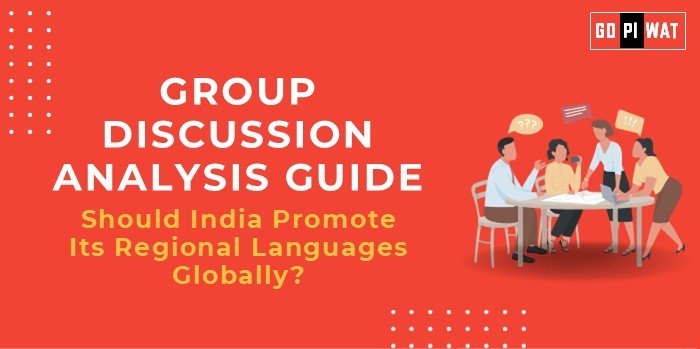📋 Group Discussion Analysis Guide: Should India Promote Its Regional Languages Globally?
🌐 Introduction to the Topic
- 💡 Opening Context: “India, a country of 1.4 billion people, is home to 22 official languages and over 19,500 dialects, making it one of the most linguistically diverse nations in the world. Promoting these languages globally could enhance cultural diplomacy and soft power.”
- 📜 Topic Background: The idea of promoting regional languages globally stems from India’s efforts to preserve linguistic heritage and leverage its cultural identity as a soft power tool. Notable examples include the global recognition of Yoga and Bollywood.
📊 Quick Facts and Key Statistics
- 📝 Languages Recognized by Constitution: 22 official languages – showcasing India’s linguistic diversity.
- 🌍 Speakers of Hindi Worldwide: Over 600 million, making it the third most spoken language globally.
- 💼 Economic Potential of Language Translation Industry: Valued at $50 billion globally, indicating untapped market potential for Indian languages.
- 🏛️ UNESCO World Heritage Sites with Language Influence: Over 40% of Indian sites have significant linguistic or cultural associations.
👥 Stakeholders and Their Roles
- 🏛️ Indian Government: Policymaking, funding global cultural events, and creating scholarships for Indian language studies abroad.
- 🎓 Educational Institutions: Introducing regional language studies in international universities.
- 🌍 Global Diaspora: Acting as ambassadors for regional languages through communities and cultural programs.
- 📚 International Organizations: Including UNESCO, for preserving and promoting linguistic heritage.
🏆 Achievements and Challenges
✨ Achievements
- 🎥 Bollywood’s Role: Indian films have brought attention to Hindi and regional languages internationally.
- 🌎 Diaspora Impact: Punjabi, Tamil, and Gujarati have strong global communities actively promoting their languages.
- 🎉 Cultural Festivals Abroad: Events like the International Hindi Conference and Tamil Sangam meetings showcase India’s linguistic heritage.
- 💻 Digital Presence: Platforms like Duolingo and Rosetta Stone now offer Indian language courses.
⚠️ Challenges
- ❌ Low Institutional Support: Few global universities teach Indian regional languages compared to European ones.
- 📉 Standardization Issues: Lack of uniform dialects complicates language promotion efforts.
- 🌐 Competition with Global Languages: English, French, and Mandarin dominate international language platforms.
🌍 Global Comparisons
- 🇫🇷 France: Promotes French globally through the Alliance Française.
- 🇨🇳 China: Funds Mandarin learning globally via Confucius Institutes.
📚 Case Studies
- 🇨🇦 Punjabi in Canada: Punjabi is the third most spoken language in Canada due to the active diaspora.
- 🇸🇬 Tamil in Singapore: Recognized as one of Singapore’s four official languages.
💬 Structured Arguments for Discussion
- 💪 Supporting Stance: “Promoting regional languages can boost India’s cultural soft power and create economic opportunities.”
- ⚖️ Opposing Stance: “Investing in promoting regional languages globally may divert resources from more urgent domestic development needs.”
- 🤝 Balanced Perspective: “While promoting regional languages is culturally enriching, it requires a focused approach to maximize returns.”
📚 Effective Discussion Approaches
- 💡 Opening Approaches:
- 📊 Statistical Opening: “India has 22 official languages, yet only a handful have significant global recognition. Should this change?”
- 📜 Case Study Opening: “Tamil’s recognition in Singapore shows how a regional language can thrive globally.”
- 🤔 Counter-Argument Handling: Emphasize India’s economic and cultural diplomacy benefits while addressing concerns about resource allocation.
🔎 Strategic Analysis of Strengths and Weaknesses
- 💪 Strengths: Linguistic diversity, strong diaspora networks, and cultural influence.
- 🛑 Weaknesses: Resource constraints, lack of global institutional support.
- 🌟 Opportunities: Growing interest in cultural diversity, rising language learning platforms.
- ⚠️ Threats: Global competition, waning interest in languages among younger generations.
🎓 Connecting with B-School Applications
- 📊 Real-World Applications: Projects in international marketing, language-driven AI applications, and cultural tourism development.
- ❓ Sample Interview Questions:
- 💡 “How can India balance promoting regional languages with maintaining its global competitiveness?”
- 📚 “What role can businesses play in promoting Indian languages globally?”
- 📝 Insights for Students:
- 📖 Link linguistic diversity to innovation in AI and translation tools.
- 🌍 Study how multilingualism affects international negotiations and diplomacy.


